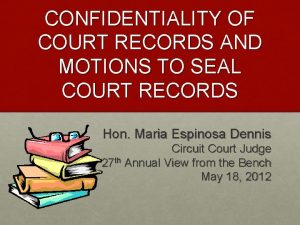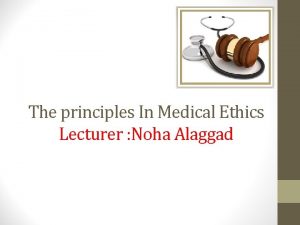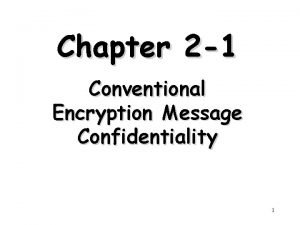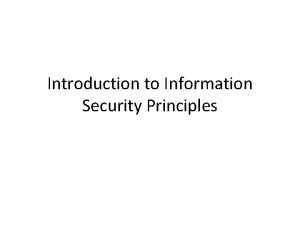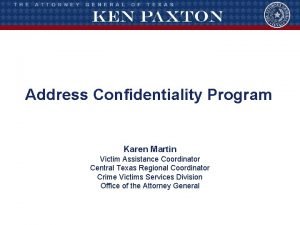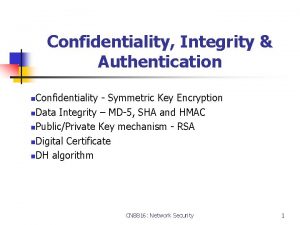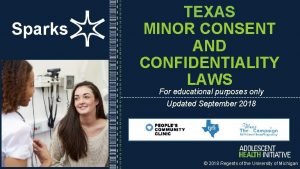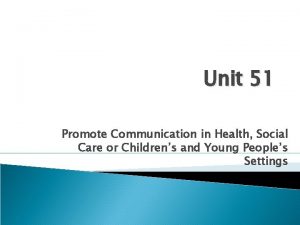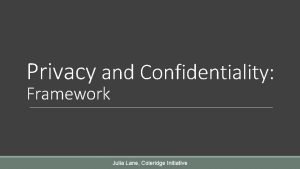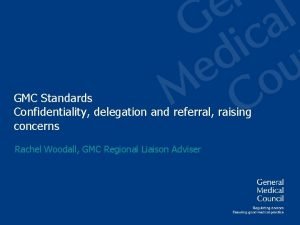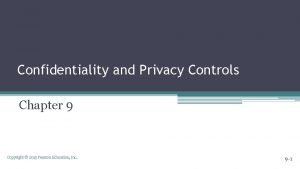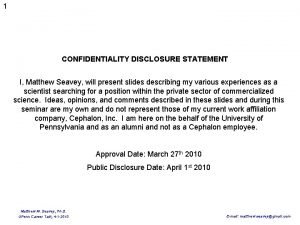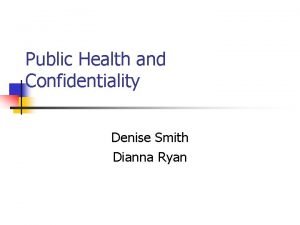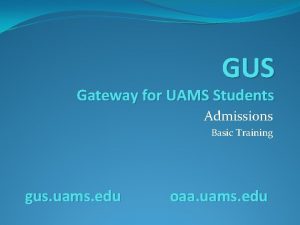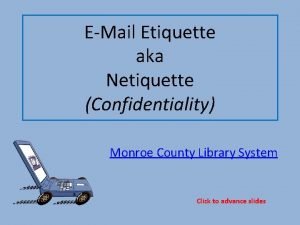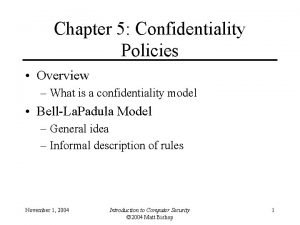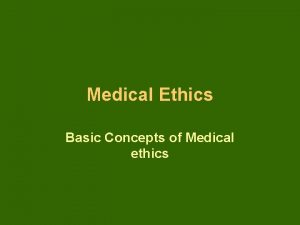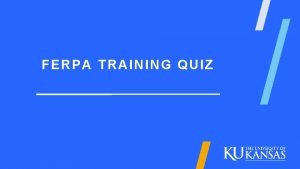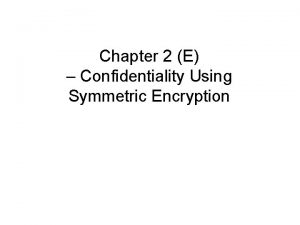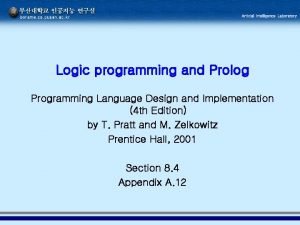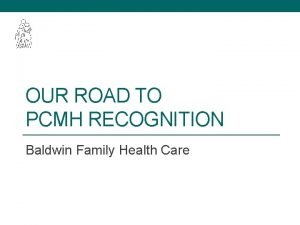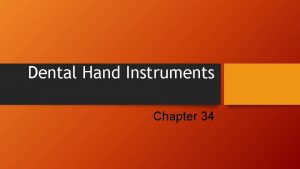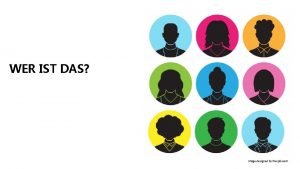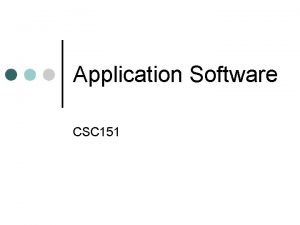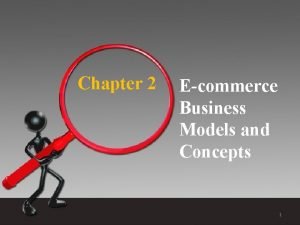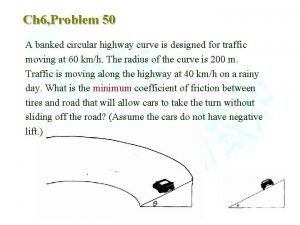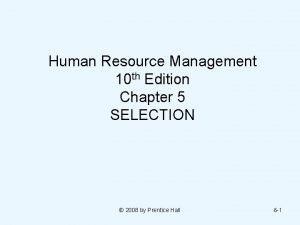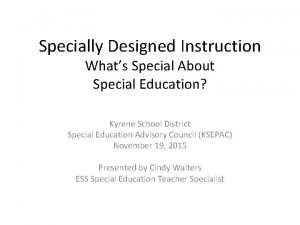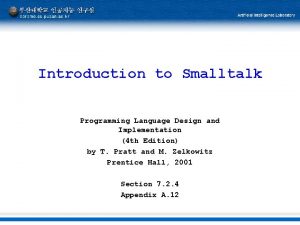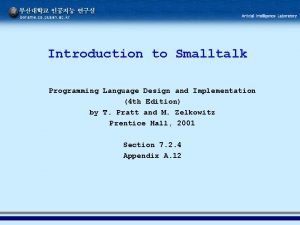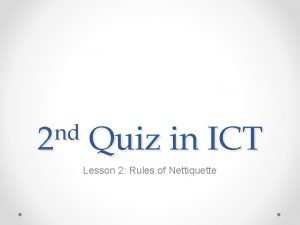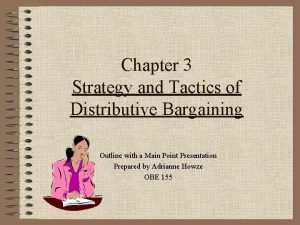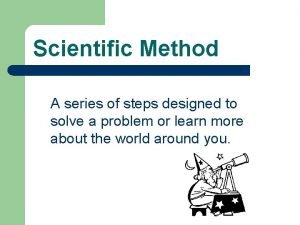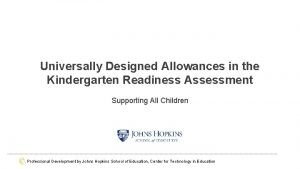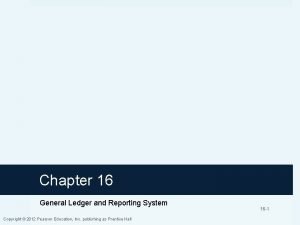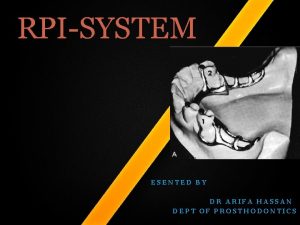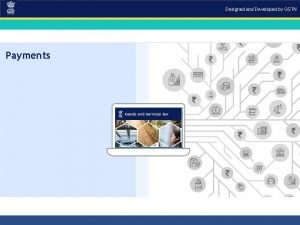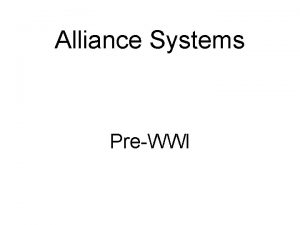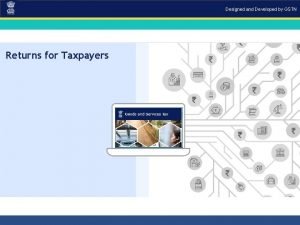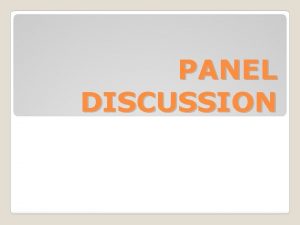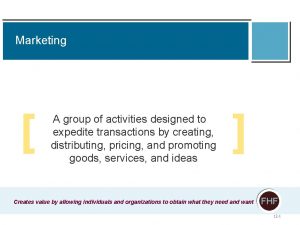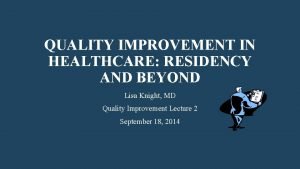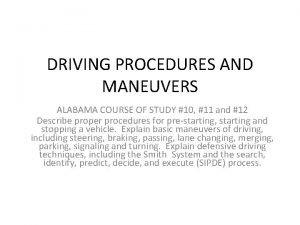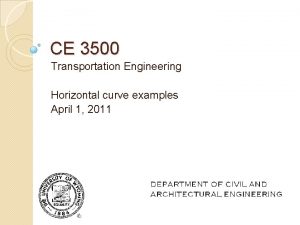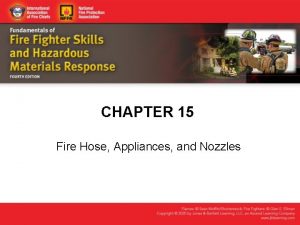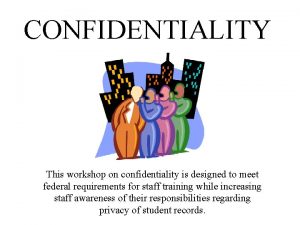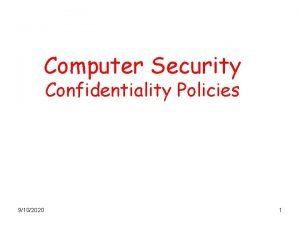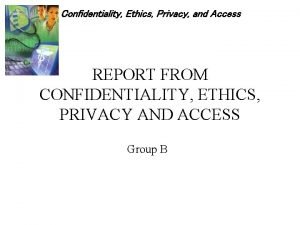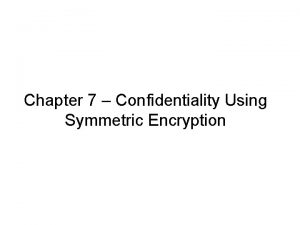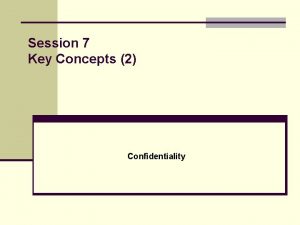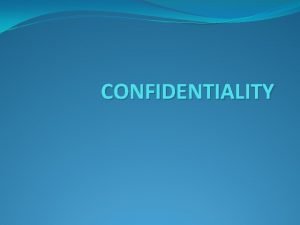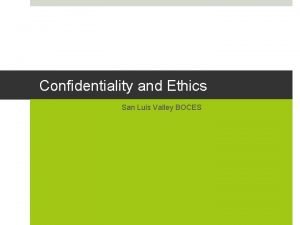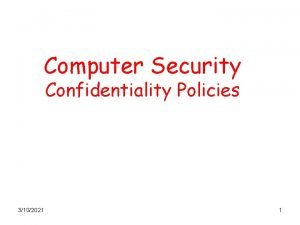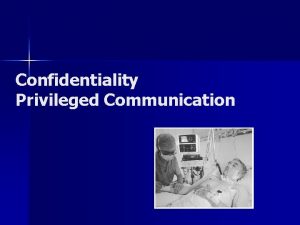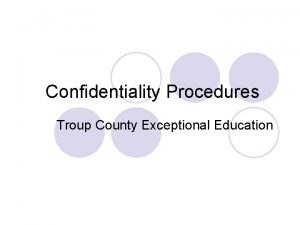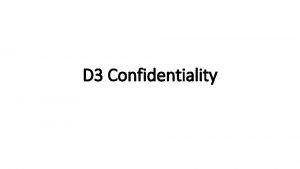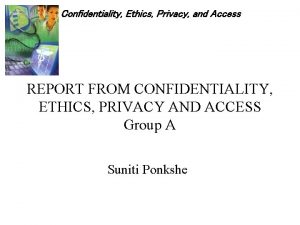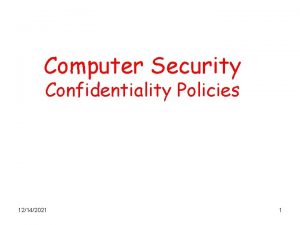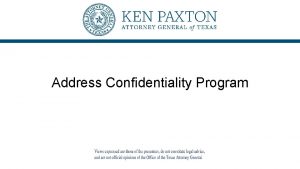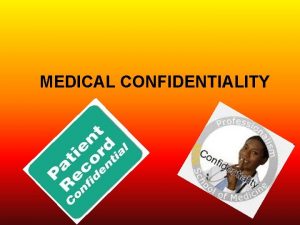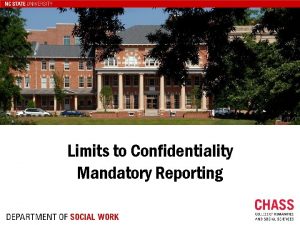CONFIDENTIALITY This workshop on confidentiality is designed to








































































- Slides: 72

CONFIDENTIALITY This workshop on confidentiality is designed to meet federal requirements for staff training while increasing staff awareness of their responsibilities regarding privacy of student records.

THREE CONFIDENTIALITY LAWS 1. 2. FERPA-Family Education Rights and Privacy Act IDEA-Individuals With Disabilities Education Act 3. PPRA- Protection of Pupil Rights Amendment

DIRECTORY INFORMATION Student’s name v Student’s address v Student’s telephone number v Student’s date and place of birth v Student’s major field of study v Participation in officially recognized sports and activities v

DIRECTORY INFORMATION v. Student’s weight, height if member of athletic team v. Dates of attendance v. Degree, awards received v. Most recent previous educational institution or agency attended

DIRECTORY INFORMATION MAY BE DISCLOSED IF: Parents are annually given public notice of the types of information designated as directory information AND v Given opportunity to refuse v

RIGHT TO INSPECT AND REVIEW RECORDS v Right to review records within a reasonable period of time of written request v Right to have representative review records v Right to response to requests for explanation and interpretation of records v Right to inspect only information related to own child v Rights extend to both parents unless otherwise indicated by law v Right to obtain copies of records

SOLE POSSESSION RECORDS Sole Possession Records are exempt from parent access if they meet the following: Must be a private note created solely by the individual possessing the note Must be a personal memory aid Not be used to develop a “plan” for the student AND/OR The information in the note must not be accessible or revealed to any other person

CONFIDENTIALITY IN PRACTICE v The district maintains a list, for public inspection a current listing of names and positions of those employees who may have access to personally identifiable information. v Staff should be aware of confidentiality laws and requirements. v Staff should comply with procedures regarding written educational records. v Staff should be sensitive to violations of confidentiality in verbal exchanges with others.

CONFIDENTIALITY MAY BE VIOLATED v When staff discusses a child in inappropriate places or situations v When staff repeats gossip or rumors about a child or his family

GOSSIP VS. . PROFESSIONAL SHARING OF INFORMATION When talking to a colleague about a student or his family, apply these four tests to see if the discussion may be violating the student’s confidentiality rights.

FOUR TESTS 1. 2. 3. 4. What is discussed? Where the discussion takes place? Who is listening? Why the discussion took place?

WHAT IS DISCUSSED If the discussion involves directory information (name, address, etc. ) there is no problem unless the parent has refused to have this information released If the discussion involves other personally identifiable information that is confidential (disability, family data, etc. ), the parties should be sure that legitimate educational interest is involved If the discussion involves information that is rumor, opinion, or hearsay, chances are that confidentiality will be in question, and the parties have moved from professionalism to gossip.

WHERE THE DISCUSSION TAKES PLACE If the discussion occurs in a private place (such as a teacher’s empty room, empty teachers’ lounge), there is no problem with confidentiality If the discussion occurs in a public place (such as the playground, the halls, a busy teachers’ lounge, the supermarket), there is a good chance that confidentiality could be violated.

WHO IS LISTENING 1. 2. If the parties to the discussion are school officials with legitimate educational interest there is no problem with confidentiality If others are listening who have no legitimate educational interest (such as a teacher who is eavesdropping, a nosy child on the playground, children in the hall, etc. ) confidentiality may be violated.

WHY THE DISCUSSION TOOK PLACE If the parties have legitimate educational interest in a student and are sharing information that will help them work with the child, then there is no problem with confidentiality If the parties are gossiping to pass time, carrying tales about a student or his family, or for other non-educational reasons, there is probably a problem with confidentiality.

TWO TEACHERS IN THE LOUNGE TALKING ABOUT A CHILD, ANOTHER WALKS IN, THEY KEEP TALKING, THE THIRD LISTENS IN, ADDS TO DISCUSSION 1. 2. 3. 4. What are they discussing? Does the third teacher have a legitimate educational interest in the child? Is the location inappropriate? Why are they discussing the child?

TWO TEACHERS SEE EACH OTHER IN THE GROCERY STORE, START TALKING ABOUT A STUDENT AT SCHOOL (“I HEAR THE FATHER DRINKS AND BEATS THE MOTHER. NO WONDER THE STUDENT HAS SO MANY PROBLEMS. ”) 1. 2. 3. Inappropriate place Others listening Content not appropriate

SCENARIOS

WHEN ASKED IF HER CONFIDENTIAL FILES WERE SECURED, THE TEACHER REPLIED, “YES. I KEEP THEM IN MY DESK DRAWER, AND WHEN I LEAVE THE ROOM, I LOCK THE DOOR TO MY ROOM. ” Was she correct?

NO. HER FILES ARE NOT SECURE BECAUSE ANYONE WITH A KEY HAS ACCESS. IT IS BETTER TO HAVE A FILE CABINET OR DESK WITH A LOCK.

WHICH SHE RECORDS NOTES ABOUT HER STUDENTS. THESE NOTES HAVE TO DO WITH THE STUDENT’S PERSONALITY, BEHAVIOR, ACHIEVEMENT LEVEL, LIKES AND DISLIKES, ATTITUDES AND THE LIKE. AS THE TEACHER IS MAKING NOTES IN THE FOLDER AFTER SCHOOL, A PARENT COMES IN AND, NOTICING THE FOLDER, ASKS TO SEE NOTES RELATING TO HER CHILD. THE TEACHER REFUSES ON THE GROUNDS THAT HER NOTES ARE NOT EDUCATIONAL RECORDS AND, THEREFORE, NOT ACCESSIBLE BY THE PARENT. Is the teacher correct in her position?

YES, IF SHE DOES NOT SHOW OR REVEAL THE CONTENTS OF THE NOTES TO ANYONE, IF SHE USES THEM AS A MEMORY AID, AND IF THEY REMAIN HER PRIVATE NOTES IN HER SOLE POSSESSION. HOWEVER, IF SHE SHARES THE INFORMATION WITH ANYONE, IT BECOMES AN EDUCATIONAL RECORD.

A PARENT WANTED TO INSPECT HER CHILD’S ACHIEVEMENT TEST RESULTS. SHE WAS GIVEN HER CHILD’S TEST BOOKLET, HIS INDIVIDUAL SCORING SUMMARY AND THE CLASS SCORING SUMMARY TO REVIEW. SHE WAS ALSO SHOWN THE DISTRICT PROFILE FOR COMPARISON. Were confidentiality procedures violated?

SUMMARY CONTAINED OTHER CHILDREN’S NAMES. A PARENT HAS THE RIGHT TO VIEW ONLY THAT INFORMATION THAT RELATES TO HER CHILD. IF THE DISTRICT PROFILE CONTAINED A GRAPH OR SOMETHING SIMILAR (WITH NO NAMES), THERE WOULD BE NO PROBLEM IN SHOWING THE PARENT.

A SCHOOL POSTS ON THE MAIN OFFICE BULLETIN BOARD A LIST OF ALL THE STUDENTS IN THE RESOURCE CLASSROOM. Was confidentiality violated?

YES. ANY LIST THAT SINGLES CHILDREN OUT VIOLATES CONFIDENTIALITY, IF THE LIST CONTAINS ANY INFORMATION OTHER THAN DIRECTORY INFORMATION.

A SCHOOL DIAGNOSTICIAN HAS A HABIT OF LEAVING STUDENTS' FILES OUT ON HER DESK DURING THE DAY. SHE USES THEM IN PLANNING EVALUATIONS AND WRITING REPORTS. Is there a violation of confidentiality?

THERE IS NO CLEAR-CUT ANSWER. LEAVING CONFIDENTIAL FILES ON THE DESK COULD BE A CAUSE FOR CONCERN IF THE OFFICE IS IN A HIGH ACCESS AREA OF THE CAMPUS. THE DIAGNOSTICIAN SHOULD BE ENCOURAGED TO CLOSE THE FILES OR REMOVE THEM FROM HER DESK WHEN SHE LEAVES. THE SAME APPLIES TO TEACHERS WHO HAVE COPIES OF IEPS. IT IS ACCEPTABLE TO KEEP THEM OPEN ON A DESK WHILE TEACHING, BUT THEY SHOULD BE PUT AWAY AT THE END OF THE TEACHING PERIOD.

A GENERAL AND A SPECIAL EDUCATION TEACHER WERE SITTING IN THE TEACHERS’ LOUNGE DISCUSSING A CHILD THEY BOTH TAUGHT. THEY CALLED THE CHILD BY NAME AND TALKED ABOUT HIS BEHAVIOR PROBLEMS, HIS FAMILY SITUATION, AND HIS DISABILITY. Were the teachers violating confidentiality?

THE CHILD IN PRIVATE (NO OTHER TEACHERS IN THE LOUNGE OR NOT WITHIN EARSHOT OF OTHERS) AND THEY HAD A LEGITIMATE EDUCATIONAL INTEREST IN THE CHILD, THEY WERE PROBABLY NOT VIOLATING THE CHILD’S CONFIDENTIALITY, BUT THEY SHOULD MONITOR WHAT THEY SAY IF OTHERS COME IN.

BULLY PREVENTION AND INTERVENTION Gus Birdwell Elementary

According to the National Association of School Psychologists, 160, 000 students per day stay home from school because of bullying (Fried & Fried, 2003). Source: www. nea. org

PART 1: BULLYING OVERVIEW AND TERMINOLOGY

BULLYING PREVENTION AND THE LAW Texas Education Code, Chapter 37 Section 37. 001 (a); Student Code of Conduct: requires each independent school district in Texas to have a local policy that: (7) prohibits bullying, harassment, and making hit lists and ensures that district employees enforce those prohibitions; and (8) provides, as appropriate for students at each grade level, methods, including options, for: managing students in the classroom and on school grounds, disciplining students; and preventing and intervening in student discipline problems, including bullying harassment and making hit list.

BULLYING PREVENTION AND THE LAW (b-1) The methods adopted under Subsection (a)(8) must provide that a student who is enrolled in a special education program under Subchapter A, Chapter 29, may not be disciplined for conduct prohibited in accordance with Subsection (a)(7) until an admission, review, and dismissal committee meeting has been held to review the conduct.

BULLYING PREVENTION AND THE LAW The requirements for prohibiting bullying, harassment, and making hit list are quite detailed and there is also a requirement in law to require the local school district policy to “ensure that district employees enforce those prohibitions. ” Under the requirements of 37. 001 (a) (8) the school district is also required to have specific options developed under local policy that are appropriate to each grade level that provide for preventing and intervening in student discipline problems, including bullying, harassment, and making hit list.

DEFINING BULLYING IN SIMPLE TERMS Real or perceived power imbalance Unwanted, aggressive behavior Repeated or potential for repeated behavior

TERMINOLOGY Target Or Victim: Student that has been bullied Bullier Or Student Exhibiting Bullying Behavior: Student that has been identified as exhibiting behavior that was determined to be bullying Witness Or Bystander: Student(s) that have observed another student being bullied **The terms in bold print are preferred language in hopes to help change thinking surrounding bullying.

PHYSICAL BULLYING Physical bullying involves hurting a person’s body or possessions. Physical bullying includes: ØHitting/kicking/pinching ØSpitting ØTripping/pushing ØTaking or breaking someone’s things ØMaking mean or rude hand gestures

VERBAL BULLYING Verbal bullying saying mean things. Verbal bullying includes: Teasing Ø Name-calling Ø Inappropriate sexual comments Ø Taunting Ø Threatening to cause harm Ø

SOCIAL/RELATIONAL BULLYING Social bullying, sometimes referred to as relational bullying, involves hurting someone’s reputation or relationships. Social bullying includes: ØLeaving someone out on purpose ØTelling other children not to be friends with someone ØSpreading rumors about someone ØEmbarrassing someone in public

ELECTRONIC OR WRITTEN COMMUNICATION BULLYING Electronic or Written Communication Bullying (including all forms of Cyberbullying) is bullying that takes place through the use of written messages or using various forms of electronic technology. Examples of Electronic bullying include: Ømean text messages or emails, Ørumors sent by email or posted on social networking sites, and Øembarrassing pictures, videos, websites, or fake profiles.

RISK FACTORS-TARGET Perceived as “being different” from peers Perceived sexual orientation Perceived ability/disability level Perceived socioeconomic status Poor social skills Socially isolated/few friends Overweight/underweight Many more…. basic premise of “perceived difference”

CHARACTERISTICS-BULLY Aggressive or easily frustrated Have less parental involvement Experiencing issues at home Think badly of others Have difficulty following rules View violence positively Lacks empathy for others

WARNING SIGNS STUDENT MAY BE THE TARGET • • • Unexplainable injuries Lost or destroyed clothing, books, possessions Frequent headaches, stomach aches or illnesses Changes in eating habits Difficulty sleeping Declining grades or interest in school Not wanting to go to school Sudden loss of friends Avoidance of social situations Decreased self-esteem Self-destructive behaviors

EFFECTS OF BULLYING Kids Who are Bullied… Kids who are bullied can experience negative physical, school, and mental health issues. Kids who are bullied are more likely to experience: Depression and anxiety, increased feelings of sadness and loneliness, changes in sleep and eating patterns, and loss of interest in activities they used to enjoy. These issues may persist into adulthood. Source: www. stopbullying. gov

EFFECTS OF BULLYING (CONT. ) Kids Who are Bullied… Health complaints Decreased academic achievement—GPA and standardized test scores—and school participation. They are more likely to miss, skip, or drop out of school. A very small number of bullied children might retaliate through extremely violent measures. In 12 of 15 school shooting cases in the 1990 s, the shooters had a history of being bullied. Source: www. stopbullying. gov

EFFECTS OF BULLYING (CONT. ) Kids Who Bully Others… Kids who bully others can also engage in violent and other risky behaviors into adulthood. Kids who bully are more likely to: Abuse alcohol and other drugs in adolescence and as adults Get into fights, vandalize property, and drop out of school Engage in early sexual activity Have criminal convictions and traffic citations as adults Be abusive toward their romantic partners, spouses, or children as adults Source: www. stopbullying. gov

EFFECTS OF BULLYING (CONT. ) On Students that Witness Bullying Incidents Kids who witness bullying are more likely to: Have increased use of tobacco, alcohol, or other drugs Have increased mental health problems, including depression and anxiety Miss or skip school Source: www. stopbullying. gov

STRATEGIES FOR PREVENTION • • Comprehensive school plan to address bullying Policy Appropriate responses/consequences to identified bullies and targets Professional development for ALL staff/faculty Parent training Build empathy Teachable moments to build community and model appropriate behavior Student empowerment Source: www. stopbullying. gov

PART 2 : BULLYING PREVENTION AND INTERVENTION FOR ALL SCHOOL STAKEHOLDERS

Bullying can occur anywhere in the school, but often occurs during free time.

In the Cafeteria Staff in the cafeteria can have a big impact on anti-bullying efforts. The less structured nature of most school cafeterias make them environments with increased opportunities for bullying behaviors. Here’s what you can do:

HOW CAN I HELP PREVENT BULLYING IN THE CAFETERIA? Create a positive cafeteria environment by treating students the way you’d like them to treat each other. Use positive non-verbal interactions – a smile or nod or thumbs up Notice something positive about the students and do or say something about it to them or someone else where they can hear it. Don’t expect students to solve bullying incidents themselves; they lack the skills. Encourage students to report incidents of bullying to you and other adults.

In the Classroom By design, students spend a majority of their school day within the classroom. Teachers, instructional aides, parent volunteers and substitute teachers have considerable interaction with students and therefore can have a considerable impact on bullying prevention. Here is what you can do:

HOW CAN I HELP PREVENT BULLYING IN THE CLASSROOM? Create a safe and supportive environment in your classroom Develop rules with your students so they set their own climate of respect and responsibility Use positive terms like what to do rather than what not to do Manage student behavior. Overall, well-managed classrooms are less likely to have bullying.

HOW CAN I INTERVENE WHEN I OBSERVE BULLYING IN THE CLASSROOM? Learn about bullying so you can effectively identify bullying behaviors Intervene immediately. It’s okay to get another adult to help if necessary. Separate the students involved Stay Calm. Reassure the students involved, including bystanders. Model Respectful behavior when you intervene. Follow your school’s incident reporting protocols. Refer the victim to medical or counseling support if necessary.

In the Hallways & Common Areas o o o Crowed hallways are environments that are capable of promoting aggressive behavior. It is important for administrators to coordinate teachers and staff to insure an adequate level of supervision. A key role can be played by custodians. The nature of their role in the school allows custodians to observe student behavior throughout the school building each day.

HOW CAN I HELP PREVENT BULLYING IN THE HALLS? Establish a culture of inclusion and respect that welcomes all students. Maintain adequate supervision in hallways and common areas at all time Role model a positive and respectful attitude when interacting with students Be aware of “Hot Spots. ” Bullying may be more likely to occur in areas with little or no adult supervision.

REMEMBER…. When you see something, do something. Intervene by separating the students involved. Get their names, but do not question students in front of other students. Report the incident to your principal/counselor. The students can then be questioned individually. Don’t try to resolve the incident on the spot Don’t assume that students can work it out without adult help. They can’t. Source: www. stopbullying. gov

SUICIDE PREVENTION

3 STEP PROCESS Observe Identify Intervene

OBSERVATION Teachers are masters of observation! You know who is struggling, who gets it, who is having a bad day, and who stayed up to late last night! You know your students’ patterns of behavior!

PATTERNS OF BEHAVIOR TO WATCH FOR… 1. Perfectionist 2. Depressed students 3. Student in real trouble for the first time 4. The abused, molested, or neglected young person 5. The gay/lesbian student 6. The learning disabled student 7. The student who has recently moved 8. The abuser of drugs/alcohol 9. The student with low self-esteem 10. The self harmer

SPECIFIC BEHAVIOR CHANGES TO WATCH FOR… Irritability, aggression, hyperactivity Frequent discipline issues Poor scores or work in all classes Change in appearance Change in relationships with peers Truancy Lack of interest in activities that used to bring joy Despairing attitude Preoccupation with death or suicide

IDENTIFICATION- BIOPHYSICAL RISK FACTORS Hopelessness History of Trauma or Abuse Impulsive or Aggressive Tendencies Previous Suicide Attempts Family History of Suicide Alcohol or Substance Abuse Mental Illness

IDENTIFICATION- ENVIRONMENTAL RISK FACTORS “WHAT ARE THEY UP AGAINST” Relationship/Social loss Easy access to lethal means Local clusters of suicide Personal media

IDENTIFICATION- SOCIAL/ CULTURAL RISK FACTORS Lack of support Sense of isolation Stigma associated with receiving help Insurance/Financial barriers to help Suicide in the media Bullying/ Cyberbullying

INTERVENTION- PREVENTION Create an open and accepting environment for all students Recognize and praise all students Promote problem solving, conflict resolution, and nonviolent handling of disputes Focus classroom discussion on positive self preservation and optimistic outlook Prevent cyberbullying in the classroom

SPECIFIC WARNING SIGNS OF SUICIDAL IDEATION Threatening to kill themselves Previous (even half hearted) attempts Depression Final Arrangements

INTERVENTION- ACT! Talk to them! Do not leave them alone. Make a plan with other school officials. Follow emergency protocols. Inform parents.

QUESTIONS! I am so glad you are all here! As soon as you have any concern about a student, please let me know!
 Motion to determine confidentiality of court records
Motion to determine confidentiality of court records 5 principles of medical ethics
5 principles of medical ethics Conventional encryption and message confidentiality
Conventional encryption and message confidentiality Confidentiality integrity availability
Confidentiality integrity availability Confidentiality ethical principle
Confidentiality ethical principle Texas address confidentiality program
Texas address confidentiality program Symmetric key
Symmetric key Texas confidentiality laws for minors
Texas confidentiality laws for minors Potential tension between maintaining confidentiality
Potential tension between maintaining confidentiality Julia lane coleridge
Julia lane coleridge Dr smith
Dr smith Confidentiality and privacy controls
Confidentiality and privacy controls Matthew seavey
Matthew seavey Confidentiality
Confidentiality Gus uams login
Gus uams login Bcc trolling email
Bcc trolling email Confidentiality disclaimer presentation
Confidentiality disclaimer presentation Confidentiality
Confidentiality Confidentiality chapter 5
Confidentiality chapter 5 Dr rubina yasmin
Dr rubina yasmin Confidentiality in medical ethics
Confidentiality in medical ethics Ferpa safe schools answers
Ferpa safe schools answers Confidentiality using conventional encryption
Confidentiality using conventional encryption In 1864 george pullman designed
In 1864 george pullman designed A shaft is designed on the basis of
A shaft is designed on the basis of Micro teaching principles
Micro teaching principles Characteristics of a well designed experiment
Characteristics of a well designed experiment Main features of war communism
Main features of war communism Prolog programming
Prolog programming Baldwin family health care
Baldwin family health care Dental hand instrument
Dental hand instrument A repeated pattern designed to generate rhythmic momentum
A repeated pattern designed to generate rhythmic momentum Balloon debate characters
Balloon debate characters Tulip shaped sherry glass
Tulip shaped sherry glass Software consists of:
Software consists of: A is the set of planned activities designed to result
A is the set of planned activities designed to result A banked circular highway curve is designed
A banked circular highway curve is designed Characteristics of properly designed selection tests
Characteristics of properly designed selection tests Specially designed
Specially designed Who designed futura
Who designed futura Smalltalk language
Smalltalk language Smalltalk
Smalltalk A program that runs in the background without you knowing
A program that runs in the background without you knowing Hardball tactics are designed to
Hardball tactics are designed to Designed for life primary care
Designed for life primary care A series of steps designed to solve a problem
A series of steps designed to solve a problem In 1864 george pullman designed
In 1864 george pullman designed Kra universally designed allowances
Kra universally designed allowances General ledger
General ledger Alfred binet designed the first ______ test.
Alfred binet designed the first ______ test. Artificial intelligence devices
Artificial intelligence devices What is asynchronous counter
What is asynchronous counter Rpi in prosthodontics
Rpi in prosthodontics Tension member in steel truss
Tension member in steel truss Commercial data meaning
Commercial data meaning Designed & developed by gstn
Designed & developed by gstn Metternichian
Metternichian Designed & developed by gstn
Designed & developed by gstn An internet is a collection of utility programs designed
An internet is a collection of utility programs designed Types of panel discussion
Types of panel discussion Upon receipt of a bad segment, udp?
Upon receipt of a bad segment, udp? A machine designed to accomplish a particular task
A machine designed to accomplish a particular task A group of activities designed to expedite transactions
A group of activities designed to expedite transactions Flat collar bearing
Flat collar bearing Every system is designed to get the results it gets
Every system is designed to get the results it gets Smith system in driving
Smith system in driving Advertising is a message designed to promote
Advertising is a message designed to promote Kevin wolf bis
Kevin wolf bis A horizontal curve is designed with a 2000-ft
A horizontal curve is designed with a 2000-ft Limited access zones around masonry wall construction
Limited access zones around masonry wall construction The 1834 zollverein was designed to do what
The 1834 zollverein was designed to do what Chapter 15 fire hose appliances and nozzles
Chapter 15 fire hose appliances and nozzles Nebuchadnezzar workshop
Nebuchadnezzar workshop
